Last updated on December 29, 2023
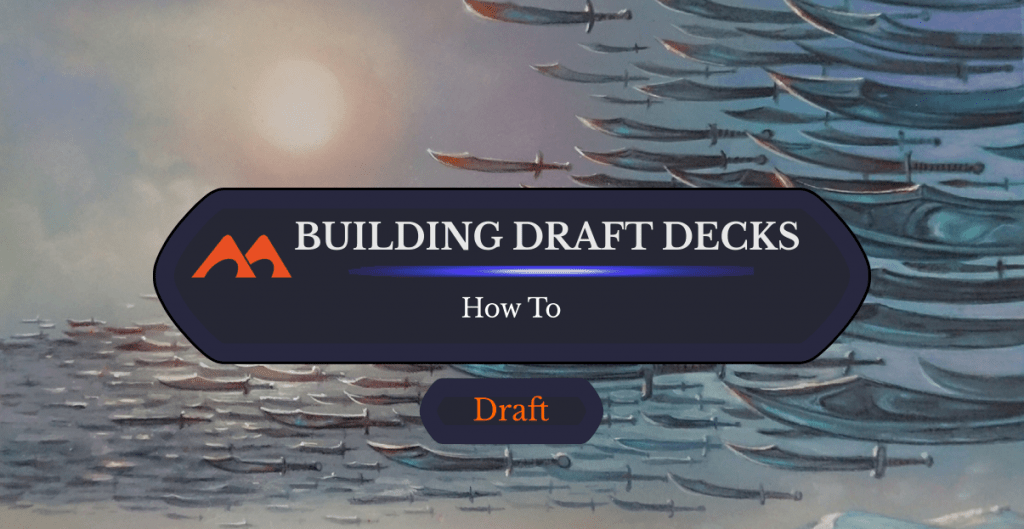
Wall of One Thousand Cuts | Illustration by Greg Staples
Greetings summoners planeswalkers!
Today I have a quick rundown on the art of cutting cards for you, an important skill for every drafter to have. I’ll show you this by going through an example deck in detail and arriving at the final 40 together.
Hopefully this will help you with your decks as well. So without further ado, let’s get started!
No More Than 40 Need Apply
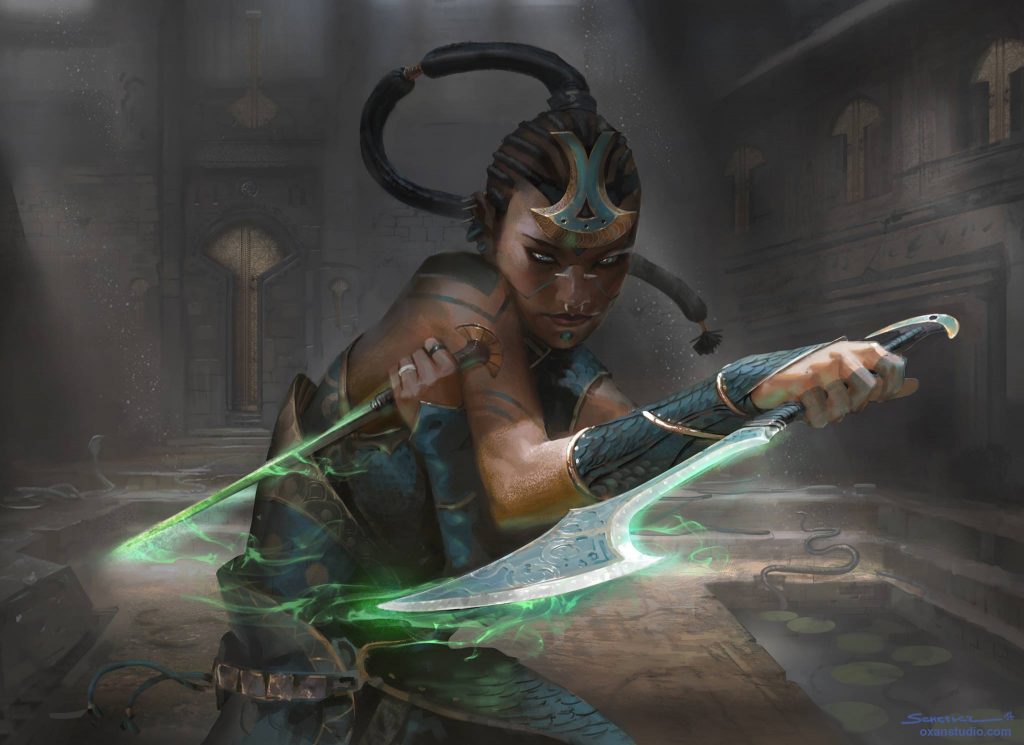
Murderous Cut | Illustration by Yohann Schepacz
One common Limited refrain you’ve probably heard a couple of times is to play no more than 40 cards. This is timeless wisdom that I basically never deviate from myself, with a few exceptions I’ll touch on a bit later.
But why do players say this? The answer is fairly simple:
- You’re more likely to draw your best cards. You wouldn’t want to reduce your chances of drawing that The Wandering Emperor, would you? A 45-card deck is over 3% less likely to draw it by turn 4, for instance.
- 40 cards and 17 lands is the most time-tested Limited ratio in existence. Adding more spells or lands messes with your deck’s composition and can dilute your draws.
- Playing over 40 cards is often the result of a player that just doesn’t know what to cut or has an emotional attachment to certain cards they’ve drafted. Release your attachments and learn how to separate the wheat from the chaff!
Example Deck: Dimir Ninjas Draft
The easiest way to teach someone how to make cuts is by example. Let’s start with a Dimir () Ninjas deck I drafted right before I started this.
By the way, if you are looking for a draft guide for Kamigawa: Neon Dynasty, you're in luck. I did an absolutely epic writeup with everything you need to know, so check it out.
Getting Started
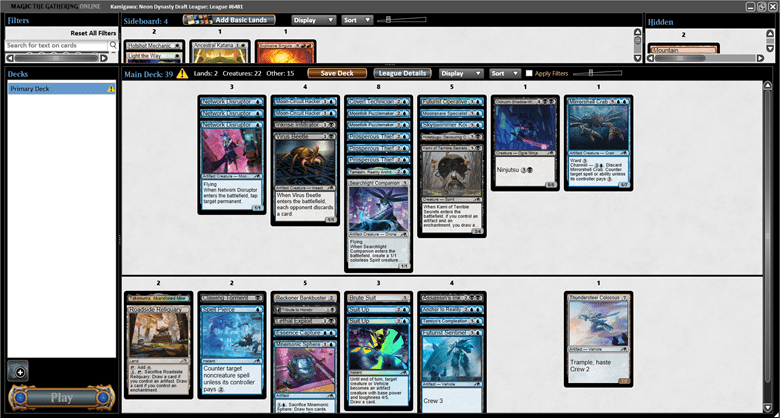
This is what the deck looks like if we have every Dimir card laid out in our pool. A bit intimidating, right? What I like to do is a fresh start. Let’s just cut all the cards from the deck and build it from the ground up!
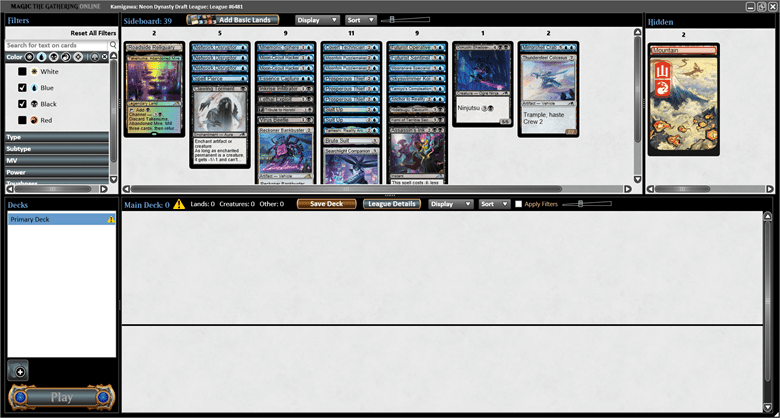
Great! Now we can evaluate our cards from the top down and figure out what we’re certain to play. Also note that I have filters for blue, black, and colorless turned on. The few red/white cards aren’t in consideration for play. The first step is to sort by rarity which can be done on Arena as well using filters.
Rares
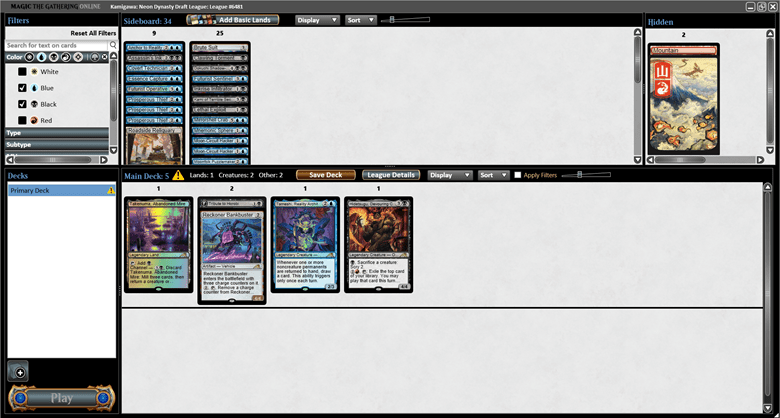
I’ve added all five of my rares into the draft deck already.
Reckoner Bankbuster is a bomb and Tribute to Horobi is another bomb that occasionally blows up your face. Tameshi, Reality Architect and Hidetsugu, Devouring Chaos are both potential bombs but need access to white and red mana to perform at their best. And then Takenuma, Abandoned Mire is a freeroll Swamp with upside and is certain to make the deck, occupying a land slot.
Uncommons
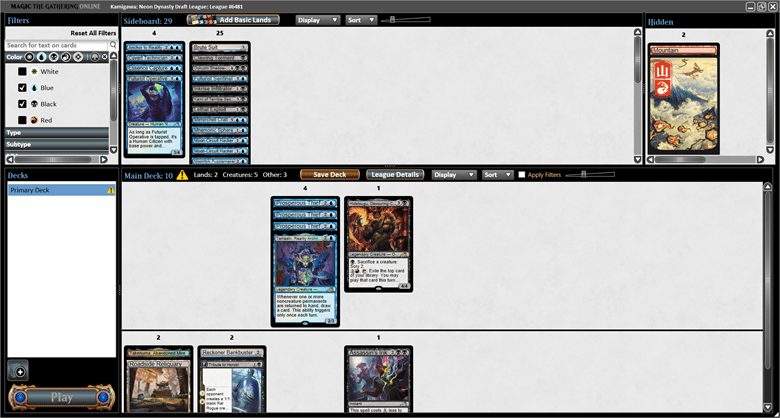
The first thing I’d like you to note for the uncommons is that I’m not adding in every playable uncommon. My technique is to focus on cards I want, and I’ll return later to add things I need after I look at the deck’s bigger picture. This will generally be premium uncommons (Behold the Unspeakable, Blossom Prancer, Twinshot Sniper) and cards I knew fit my deck as I was drafting it.
In this case, Assassin's Ink fits the “premium uncommon” idea while Prosperous Thief is a vital card to the deck I’ve built. While I like Thief in general, I especially like it when it produces red/white mana for my rares. With three Thieves and a number of other rogues/ninjas I can support Tameshi/Hidetsugu without playing a single Plains or Mountain. The Thieves also stack well in multiples, acting as Treasure lords for each other of my rogues/ninjas.
Commons
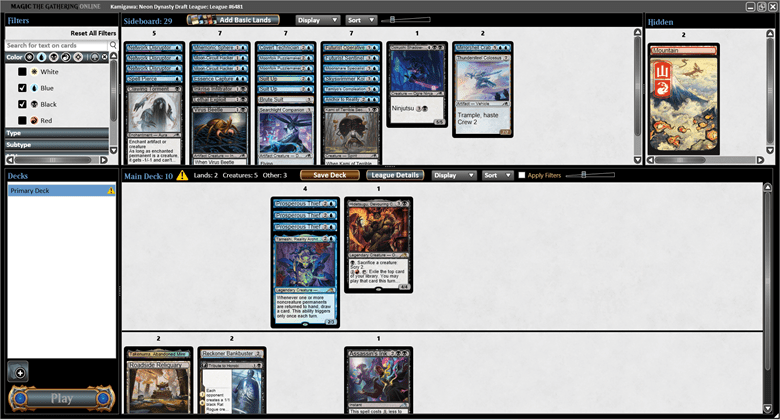
Because there are many more commons than uncommons I’ll go into more detail about what commons I’m immediately adding and why.
- Three Network Disruptors get added for being a premium ninjutsu enabler and an evasive creature for my three Prosperous Thiefs.
- Two Moon-Circuit Hackers as one of the best common ninjas, and we have great ways to sneak it in.
- Inkrise Infiltrator is the second-best common ninja enabler behind Disruptor, plus it’s evasive for our Prosperous Thief.
- Virus Beetle is a good rate, good with Tameshi, and very punishing with ninjutsu if our opponents let “1 damage” in.
- We don’t have Containment Construct or a ton of artifact synergies, but Mnemonic Sphere is still decent card draw regardless, especially in a deck with lots of potential mana from Treasure.
- Searchlight Companion is a good ninjutsu enabler and the only 3-of I’m adding for now.
- Moonsnare Specialist and Tamiyo's Compleation are my strongest 4-ofs and cards I’m 100% sure will make the final cut.
- I have enough fliers to know that Dokuchi Shadow-Walker will cost enough to be good in my deck.
The Final Options

Assuming we play 17 lands (more on that later), we currently just need three more cards to finish this deck. So what does our deck need at this point?
- Our removal spells are lacking with just two right now. Our options for additional creature removal are Clawing Torment (aggressive card that can kill X/1s) or Lethal Exploit (always -2/-2 unless we crew Bankbuster). Neither is a great option but both are viable now or post-board.
- If we want to play some counterspells there’s a good early game plus lots of potential Treasure from Prosperous Thief for surprise interaction. Essence Capture is and narrow but a good rate. Mirrorshell Crab is my preference for its broad number of useful scenarios the early and late game. I don’t main deck Spell Pierce much but it can be good against decks leaning on Imperial Oath, The Kami War, or other expensive noncreature spells.
- Suit Up is a great trick in creature-dense decks that can get ahead on board early. We fit this description nicely so I’m certainly playing one and considering a second.
- We have plenty of decent creatures we could add. Covert Technician is a good blocker and a ninja, but it’s ability won’t add much to the deck. Skyswimmer Koi and Futurist Operative are both solid playables I’m eyeing here. Counting the enchantments (just four) reveals Kami of Terrible Secrets as a weaker option.
- Finally we have the Anchor to Reality plus Thundersteel Colossus combo if we want to get frisky. There’s a lot of cheap artifacts to sac between Network Disruptor, Virus Beetle, and Treasure tokens, so Anchor is easy to cast. But we have only two targets (Bankbuster is the second), and only one is great off Anchor.
Finishing It Off
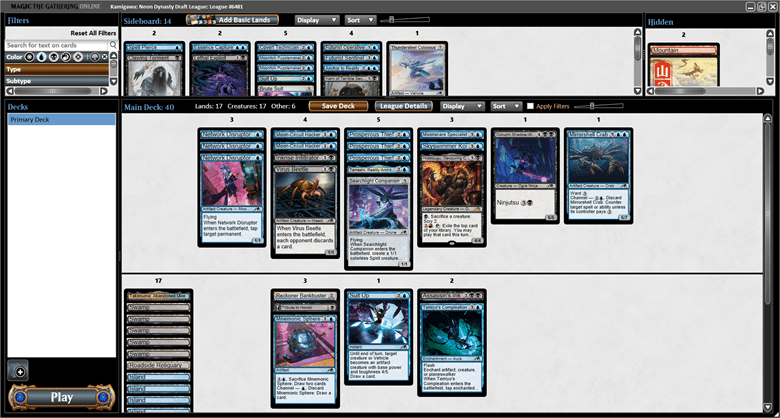
I decided the deck needed more power and liked the one Suit Up, so I added that plus Skyswimmer Koi/Mirrorshell Crab. Skyswimmer is a decently sized flier that can pay us off for making so many Treasure tokens, and Mirrorshell is both a tricky counterspell and an exciting card to cast off of Treasure early.
Cards I’d expect to sideboard from this point are:
- Spell Pierce against expensive noncreatures or decks with few creatures in general.
- Clawing Torment and Lethal Exploit against decks with a lot of small threatening creatures like Lizard Blades and Blade of the Oni.
- Essence Capture against lots of clunky high-end creatures, usually from a big green deck like Blossom Prancer and Greater Tanuki. Be careful, though, because saga creatures can punish you for leaning on this.
- Covert Technician and Moonfolk Puzzlemaker are available blockers against aggro decks leaning on 2/2s, 3/1s, and 3/2s.
- I probably wouldn’t ever board the Anchor combo in this deck, but it’s an option if you wanted to cheese someone.
So what would I take out?
- The core ninjas/enablers are basically non-negotiable, no matter what the deck looks like. Two bomb rares depend on Prosperous Thief to be at their best, and the Thieves depend on our enablers.
- Suit Up can be difficult to use on the back foot so I sometimes cut this kind of card against aggro if I don’t think I’ll be able to use it safely. Mirrorshell Crab is a similar class of card since its worst matchups are against opponents who can deploy threats before you can even hold up Convolute. Mnemonic Sphere could also be trimmed in similar matchups because we have a ton of muscle through our rares anyways.
- Skyswimmer Koi can be substituted for Futurist Operative against decks with several ways to deal three damage like Ninja's Kunai and Kami's Flare.
- Tamiyo's Compleation is a nice broad removal spell, but certain swarm decks don’t have a lot of good targets and can punish you for waiting for one.
I wouldn’t expect to board more than two or three cards in or out with this deck in general. The core of it is too solid and self-involved for dramatic sideboarding and our options for boarding aren’t the most impressive either.
If you want to learn about sideboarding in limited more, I recommend the courses by Ben Stark and Seth Manfield on Spikes Academy.
The Steps to Building a Draft Deck
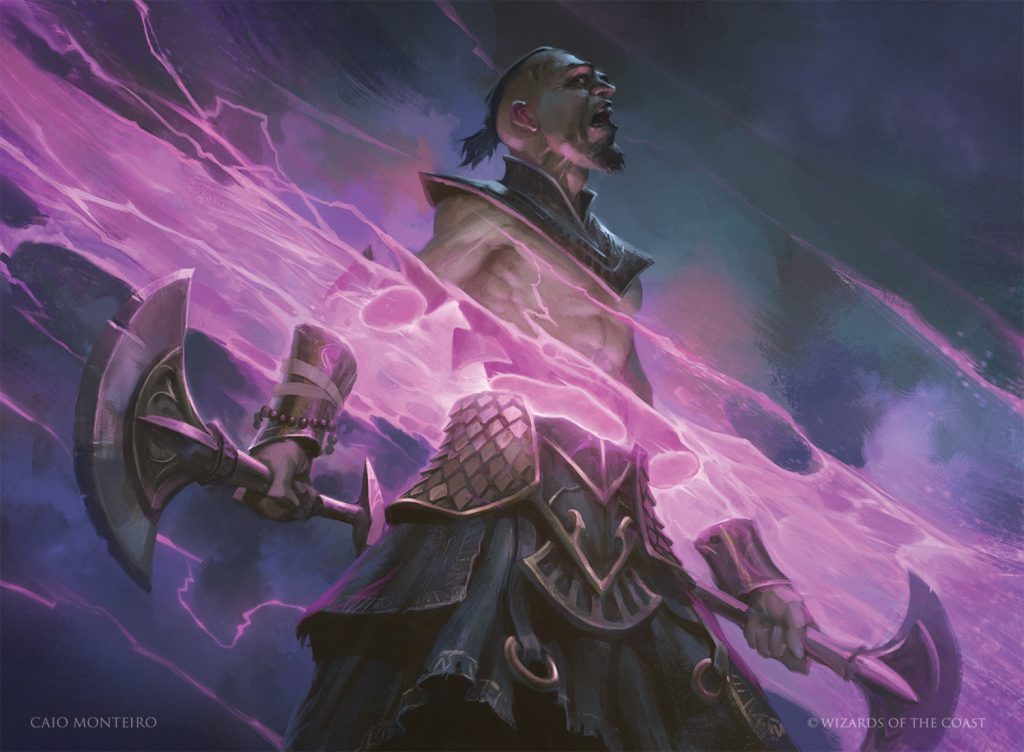
Cruel Cut | Illustration by Caio Monteiro
Try running through these steps with your own Draft decks if you’re stuck and need cuts:
- First, cut everything if you’re lost. This is the best way to get a clean frame of mind for your deck.
- Sort by rarity as though you were playing Sealed. You don’t have to add in every card with a rare symbol, but you should have a good idea what cards you’re 100% going to play.
- Then move on to uncommons. Add the best ones for your deck and make a note of cards that aren’t quite at that level.
- Commons follow. Sort by curve or just overall color view and then start adding cards that really suit your strategy or are just generally high quality. Archetype staples, removal spells, and top commons are usually what you add at this stage.
- Take a breather and assess how far you’ve come and how many more cards you have to add. In the example I only needed three cards, but you could have a less busted Draft deck and need to add more filler.
- Filler is best evaluated by measuring it against your curve, amount of interaction, and potential synergies.
- Once you have a workable 23 cards, give your pool an overall look again and think about if there are some adjustments you could make to improve your deck.
- Last you’ll have to decide on your mana base. I didn’t touch on this in the example explanation but I color sorted and saw 15 blue cards and only six black. I also noted the three Network Disruptors and other early-game blue cards. So 10 Islands and 5 Swamps were my choice for how to do my mana.
- Now that you have a deck, send it to your friends (or the Draftsim Discord) and ask them for a second look. Or just send it to them to brag about how many rares you drafted!
Exceptions are the Rule: Building 5-Color Draft Decks
This step-by-step process is probably going to be the worst for 5-color piles where you aren’t really sure which colors you’re playing. 5-color decks can also sometimes have a very high number of playables if you’ve drafted enough fixing, further confusing you and this process.
While my process for 5-color decks is fairly similar (start with rares/bombs, add the best uncommons), I also start with adding all my fixing too. After that I add my best commons and other playables and can start to build the mana base around the spells in front of me. I’ll try to reverse engineer this process with an example deck.
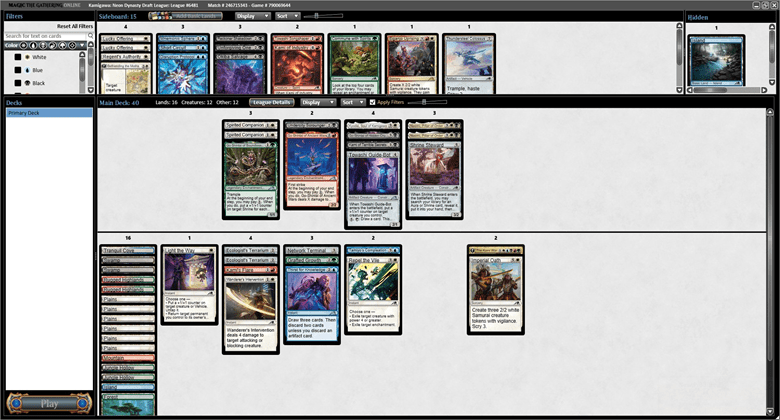
While we’re starting from a full build here, if you handed me this pile of cards unmade I would’ve made note of some things.
- Rares and Mythics: Kyodai, Soul of Kamigawa, The Kami War, and Eiganjo Uprising. I don’t like Uprising in general but especially not in durdly decks, so I’d ignore it and auto-include the first two for 2 of 23 cards added.
- Uncommons: Three shrines plus a Shrine Steward (technically a common), a pair of Naomi, Pillar of Orders, Thirst for Knowledge, and Towashi Guide-Bot as a generally decent Azure Mage equivalent all stick out. Adding all of them puts us at 10 of 23 cards.
- Fixing: Thankfully there’s quite a bit of fixing. Two Ecologist's Terrariums, Network Terminal, Grafted Growth, and five dual lands. When you play The Kami War you almost never cut any fixing. Adding those four puts us at 14 of 23 cards.
- Power Commons: Removal is vital for 5-color control strategies, so all of our common removal spells are under consideration. Short Circuit and Lucky Offering are excluded, one for being narrow (Offering) and the other for just being a very weak card (Circuit). Spirited Companion and Imperial Oath are our best commons and great for a value-oriented strategy. Kami of Terrible Secrets has the same deckbuilding consideration as Naomi, Pillar of Order and is a nice value creature. Adding all this puts us at 22 of 23 cards.
- Filler: Undercity Scrounger is a blocker that can make occasional sources of colored mana, and another artifact for Naomi. Light the Way is a playable trick that can go off with The Kami War. Either one of these puts us at 23 of 23 cards.
- Mana Base: 16 lands was my default instinct since we have four spells that act as mana sources. Grafted Growth is awkward in a deck with only two green spells but I still had seven sources for a turn 3 Growth thanks to the duals and Terrarium. I think cutting it for a 17th land would have been better than playing it. We need one of each basic for Ecologist's Terrarium regardless. If you decided on 16 like I did, you’d add the other filler playable as a 24th card, which for me was Light the Way.
- Basic Distribution: We have four innate sources of each color from Ecologist's Terrarium and Network Terminal plus one basic. Our five duals give us one white, one blue, two black, two red, and four green. With the spells we’re playing we need extra Plains and not much else besides one of each other basic.
- Final Mana Sources: 8+4W, 2+4U, 4+4B, 3+4R, 5+3G. Grafted Growth doesn’t count since it requires green mana. Pretty decent and, casting The Kami War was easy in practice.
Wrap Up
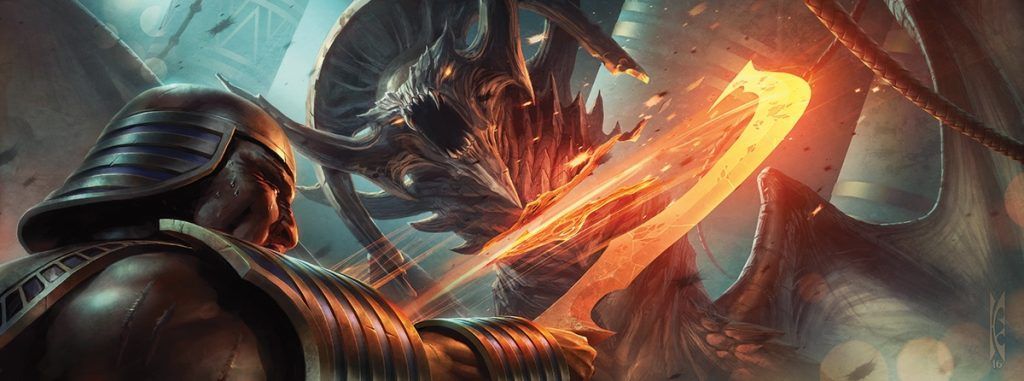
Cut // Ribbons | Illustration by Raymond Swanland
If you found this useful let me know in the comments down below or over on the official Draftsim Discord. I’d be more than happy to do more write-ups detailing more complicated examples of cuts from drafts I’ve done.
And if you're not using Arena Tutor for MTG Arena — you should be. It gives you expert recommendations on what to do while you're drafting and building your decks.
Hopefully more readers found this useful than not, but either way I’ll be back with more soon enough.
Happy drafting, and may your P1P1s always be busted rares!
Follow Draftsim for awesome articles and set updates: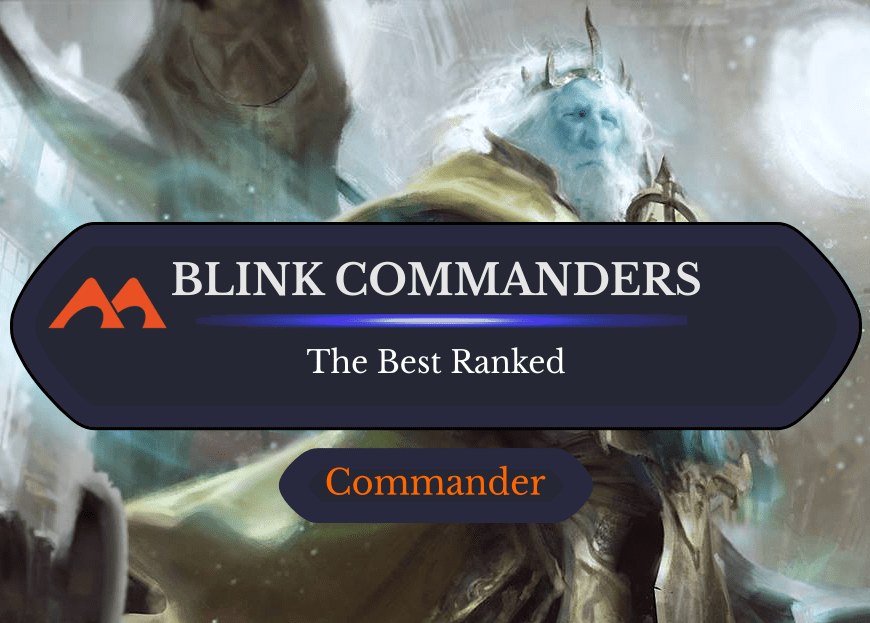
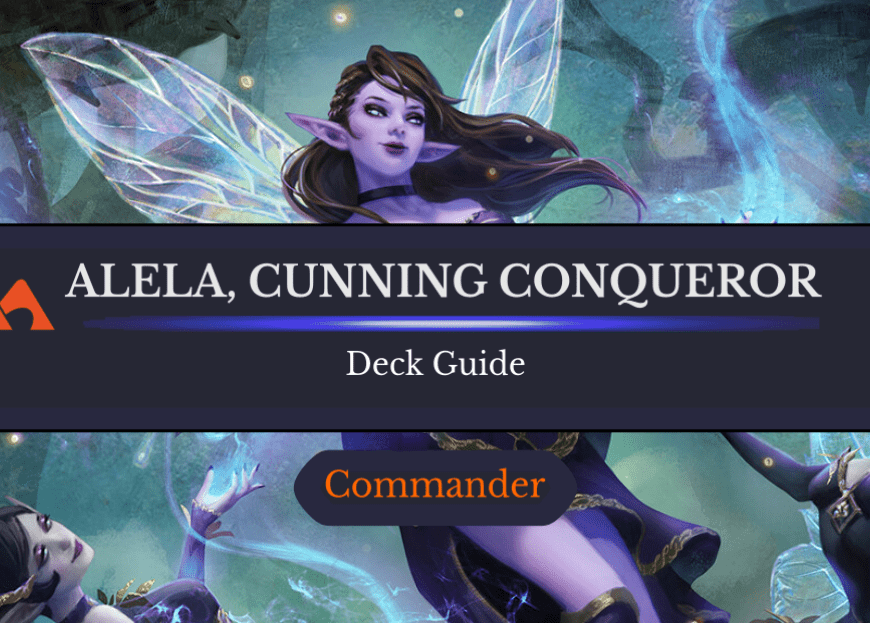
2 Comments
There’s a common case to play 41 card – when you need land/spell ratio neither 16/24 nor 17/23, but smth between.
Can you give a little more detail about this? 🙂 I rarely find this to be “common,” so I’m curious to hear about how and when you know that you are supposed to have exactly 41.4% lands instead of 40% or 42.5%…
Add Comment